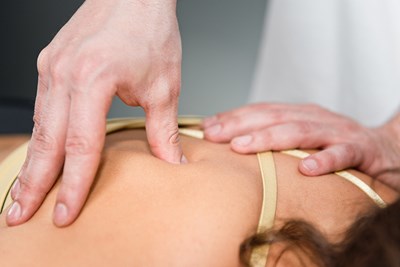Trigger points are small areas in the fascia that form as a result of strain or injury to the muscle. The fascia is normally a flexible, weblike structure; these injuries can make it brittle, interrupting movement all over the body. Although trigger points may be the source of the injury, they are not usually the site of the pain. Here’s a look at the other symptoms of trigger points.
Trigger Points and Myofascial Pain Syndrome
Trigger points cause what is known as “referred pain.” Referred pain is the phenomenon in which the trigger point (TrP) is in one place, while the pain is somewhere else. These aren’t extreme references -- a trigger point in your calf won’t cause pain your neck. But a TrP in your shoulder could cause neck pain. TrP correspond to various muscles and muscles groups -- generally one at a time -- creating localized, rather than generalized muscle pain. One trigger point might cause some pain and discomfort for a while. Several TrPs cause myofascial pain syndrome.
Types of Trigger Points
There are four different types of trigger points. An active trigger point is one that is causing pain now. A secondary trigger point, on the other hand, may be interfering with movement and flexibility, even causing a little bit of discomfort, but it is not actively causing the associated muscle or muscle group significant pain. It does, however, hold the potential to cause that pain if your muscle gets overworked or otherwise injured. A latent trigger point might become a TrP but isn’t currently causing significant problems. Satellite myofascial points have a little bit in common with both of the latter types of trigger points; it’s a little bit uncomfortable, but it isn’t performing the exact job of a trigger point at this particular time. The important difference, however, is that it isn’t exactly a trigger point anymore because another trigger point has essentially taken over its territory.
Symptoms of Trigger Points
The ultimate sign of a trigger point is pain. While muscle pain normally gets better after a few days, trigger points don’t. They get worse, and they continue to get worse until they significantly interfere with movement, flexibility, and activity. Trying to “walk it off” or engage in activity despite this pain generally exacerbates the issue. Depending on where the trigger point is located, you may have trouble walking up stairs, lifting, swallowing, bending over, and about a myriad other tasks that seem simple until you find yourself in frequent, if not constant, pain. Eventually, as a TrP turn into myofascial pain syndrome, you may notice the onset of depression and other changes in behavior.
Sleep is often associated with trigger points, but this seems to be a “chicken and egg” sort of connection. Being frequently tired and not getting sufficient sleep seem to play a large role in the development of TrP and myofascial pain syndrome. On the other hand, developing TrPs can disrupt sleep. This may be particularly true depending on where your trigger point is located. For example, a trigger point in your back may be disrupting muscles all up and down the spine, making it difficult to get comfortable in order to get good, quality sleep. Some patients even notice gastrointestinal upset, from vomiting to diarrhea. If you suspect you are developing trigger points, talk to your doctor about where to find the best treatment in your area.



